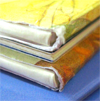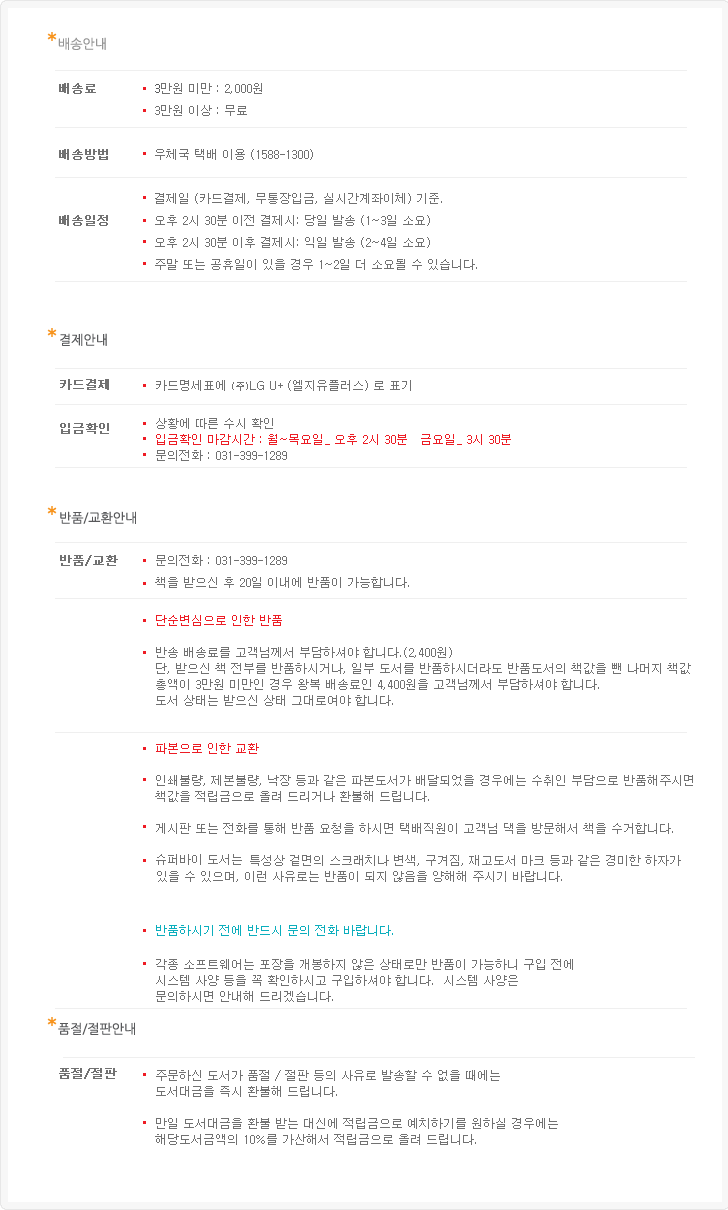|
|
|
|
|
|
|

| 최근 이 책을 구매하신 다른 회원의 책장 |
|
 |
|
|
|
[ 책 소개 ]
세계 각 지역의 다양한 시장 모습을 Caldecott 수상작가인 Ted Lewin이 간결한 설명 문장과 함께 세밀하고 사실적인 수채화 그림으로 보여줍니다.
삶의 생동감이 넘쳐 흐르는 세계 각 지역의 다양한 시장들.
태국의 수상시장, 인도의 저녁 꽃시장, 페루 마추피추 아래 마을의 기찻길 옆 재래시장, 이집트 카이로 외곽의 낙타시장, 미국 뉴저지주 램버트빌 외곽의 | 닫기x |  What is 벼룩? What is 벼룩?
하프에서는 저렴한 가격으로 해외 질좋은 엄선된 수입 원서를 공급하려고 노력합니다.
벼룩 제품은 해외에서 진열되던 상품이나, 재고품을 이야기합니다. 따라서 표지의 긁힘,찌그러짐 등의 흔적이 있을 수 있지만 속내용은 새제품이나 다름이 없습니다. 하프에서 원가보다 절반 이상 싸게 판매하는 제품을 말합니다.
|
큰 사이즈의 튼튼한 | 닫기x |  What is What is | 닫기x |  What is 하드커버? What is 하드커버?
양장본이라고도 불리우며, 표지가 단단한 판지로 만들어진 책입니다.
판지를 천이나 가죽으로 감싸기도 합니다. 책의 속지는 일반적으로 중성처리된 종이(Acid-free paper)를 사용해서 잘 변질이 되지 않기 때문에 오랫동안 보관하기에 적합합니다. 이 종류의 책은 더스트 재킷, 또는 더스트 커버로 불리는 표지덮개가 함께 있는 경우가 많습니다. 간혹 내부 속지가 콩기름 코팅이 된 경우 고약한 냄새가 나는 책도 있습니다.
|
양장본이라고도 불리우며, 표지가 단단한 판지로 만들어진 책입니다.
판지를 천이나 가죽으로 감싸기도 합니다. 책의 속지는 일반적으로 중성처리된 종이(Acid-free paper)를 사용해서 잘 변질이 되지 않기 때문에 오랫동안 보관하기에 적합합니다. 이 종류의 책은 더스트 재킷, 또는 더스트 커버로 불리는 표지덮개가 함께 있는 경우가 많습니다. 간혹 내부 속지가 콩기름 코팅이 된 경우 고약한 냄새가 나는 책도 있습니다.
|
| 닫기x |  What is 하드커버? What is 하드커버?
양장본이라고도 불리우며, 표지가 단단한 판지로 만들어진 책입니다.
판지를 천이나 가죽으로 감싸기도 합니다. 책의 속지는 일반적으로 중성처리된 종이(Acid-free paper)를 사용해서 잘 변질이 되지 않기 때문에 오랫동안 보관하기에 적합합니다. 이 종류의 책은 더스트 재킷, 또는 더스트 커버로 불리는 표지덮개가 함께 있는 경우가 많습니다. 간혹 내부 속지가 콩기름 코팅이 된 경우 고약한 냄새가 나는 책도 있습니다.
|
[ 서지 정보 ]
Edition : Hardcover: 40 pages
ISBN-10: 068817552X
ISBN-13: 978-0688175528
책 크기 : 28.6cm x 24.3cm
[ 영문 서평 ]
From the Publisher
How much for... fried bananas in Bangkok, a mandolin in New Jersey, llama-wool ponchos in Peru, or a camel in Cairo? With Caldecott Honor artist Ted Lewin's richly colored and detailed landscapes, how much? takes readers deep into the heart of bustling marketplaces all around the world. So come along with us -- you never know what treasures you'll find!
Publishers Weekly
Ted Lewin presents another lavishly illustrated book to follow his Market! (in a starred review, PW said Lewin's tour of famous marketplaces "takes an everyday experience as an occasion to explore ethnic diversity"). This companion continues his tour of the globe to ask the question, How Much? Visiting Markets Around the World. A fried banana in Bangkok, Thailand, costs 20 bahts ("approximately fifty-three cents," explains Lewin); at the camel market in Cairo, Egypt, the author contemplates whether a camel will be sold as "a beast of burden or a pet," and, back in New Jersey, an ancient painted puppet from China goes for $25.
Children's Literature
Need a camel, want to taste a fried banana dusted with cocoanut sugar, or just take a spin through a typical American flea market? Ted Lewin, the Caldecott Honor Artist, once again transports his readers to fascinating market scenes throughout the world as he did in his 1996 book Market! His wonderfully detailed illustrations let you feel the water lapping against the boats in a floating market in Thailand, experience the narrow dark tunnels of stalls in an Indian market, and feel the dusty hot sun in a camel market in Egypt, among other market scenes. Each time you look at his beautiful drawings you seem to notice details you have not seen before. The accompanying text gives some short exotic descriptions of what is happening in the markets. Unfortunately this text seems to be written for adult readers rather than the intended audience of five to nine year olds. Much of Lewin's vocabulary would make good SAT prep work for high school students, including words like stifling, labyrinth, oblivious, wielding, and disgorging. This book is a feast for the eyes but the text could use a good rewrite for the typical picture book reader.
School Library Journal
Lewin captures the excitement and unexpected beauty of marketplaces on four continents. He presents eight diverse outdoor venues, each one unique in its wares, from camels outside of Cairo and boats laden with fruit in Bangkok to a flea market in a New Jersey parking lot. Lewin accompanies each double-page watercolor scene with a poetic narrative that paints an equally rich picture. Art and text work together to bring all senses into play. In a flower market in Madras, India, for example, the author describes the scent of flower petals and freshly cut stalks, the visual delight of colorful petals heaped in baskets, voices bartering, and bodies crammed into the crowded, dimly lit bazaar. And while he accurately depicts the cultural and geographic differences of markets across the world, Lewin also shows that buying, selling, and bartering, as well as the language of trade, are universal. The author even presents the phrase "How much?" in a variety of languages, and includes a phonetic pronunciation guide. A fine choice for libraries looking for an accessible and captivating book about the world's marketplaces.
Kirkus Reviews
Although Lewin has already introduced readers to markets in an earlier effort, he retains the ability to fascinate viewers of all ages with his complex images, authentic representations of people and places from around the globe, and his practiced traveler's eye, which allows him to select a moment in time and capture it with his brush. The busy centers of commerce in his luminous paintings include a floating market in Thailand, a flea market in New Jersey, an Egyptian camel market and a train-side market on the way to Machu Picchu, the site of an ancient Incan city in Peru, where backpackers and tourists stop for souvenirs and supplies. A few sentences poetically describe the markets, the products on sale and the people peddling their wares. Young armchair travelers will taste the foods, hear the crowds and long to buy a treasure from the boy at the flea market selling his action figures. |
|
|
|
|
 |
제품상제정보 배송/반품/교환 안내 |
|
|
|
Super Buy 도서는 미국 출판사의 재고도서(Remainder Book), 초과출간도서(Excess Inventory), 할인도서(Bargain Books)
등을 직수입해서 정가의 55%~80%를 할인한 가격에 판매하는 제품입니다.
Super Buy 책의 품질은 거의 새 책과 같은
수준이지만, 간혹 커버의 스크래치나 접힘과 같은 하자나, 책 하단의 재고도서 마크가 있을 수 있습니다.
저렴하게 판매하는 Super Buy 제품의 특성상 반품이 되지 않습니다만, 파본인 경우에는 착불로 반품하시면 책값을
환불해드리거나 적립금으로 올려드립니다. (반품 전에 연락 요망)
하프프라이스북에서는 중고도서(second hand book)를 취급하지 않습니다.
|
|
 총 3건의 독자서평이 있습니다. 총 3건의 독자서평이 있습니다. |
|
 How Much? How Much? |
제목 그대로 세계 각국의 시장모습을 보여주는 책이에요. 이 책은 그림으로 되어 있지만 왠지 실사로 되어 있는 세계 각국의 빵을 보여주는 bread, bread, bread 책이 생각나기도 합니다. 이 책에서도 소박한 시장풍..

제목 그대로 세계 각국의 시장모습을 보여주는 책이에요. 이 책은 그림으로 되어 있지만 왠지 실사로 되어 있는 세계 각국의 빵을 보여주는 bread, bread, bread 책이 생각나기도 합니다. 이 책에서도 소박한 시장풍경을 가감없이 그대로 보여주고 있어요. 각 나라의 특징이 되는 물건들이나 사람들 모습을 보여주고 있기 때문에 각 나라에 대한 이해를 도울 수도 있을 것 같아요. 가령 태국에서는 배를 타고 다니는 물위의 시장이나, 이집트에서는 (사막에서 입는) 흰옷을 입은 사람이 낙타를 사고 있다던가… 나라 이름과 시장이름도 쓰여 있어서 조금만 내용을 더 추가해 세계의 시장을 구경하는 여행 안내서 같은 책으로 보아도 괜찮겠다 하는 생각도 드네요.
 |
평점      | 조회 (60) | 추천 (15) | 홍지영 2008/11/11 | 조회 (60) | 추천 (15) | 홍지영 2008/11/11 |
| |
 세계의 시장모습.. 세계의 시장모습.. |
우리에게 다소 생소하지만 세계 구석구석의 다양한 시장의 모습을 보여주고 싶어
구매한 책입니다.
왁자지껄 다양한 것들을 사고, 팔고 흥정하는 모습은 어딜가나 비슷한 것 같아요.
그림이 어디서 많이 본 듯한 ..

우리에게 다소 생소하지만 세계 구석구석의 다양한 시장의 모습을 보여주고 싶어
구매한 책입니다.
왁자지껄 다양한 것들을 사고, 팔고 흥정하는 모습은 어딜가나 비슷한 것 같아요.
그림이 어디서 많이 본 듯한 느낌이 들어 확인해봤더니 'Peppe'라는 책의 삽화가 작품이었네요.
돛단배를 타고 오가며 장사를 하는 태국의 수상시장에서 인도, 페루, 이집트, 그리고 미국의
벼룩시장까지 다양한 곳의 생생한 모습을 엿볼 수 있는 책입니다.
단, 책 페이지수가 적은 편이라 세계 각국의 다양한 시장모습을 한 권에 담기엔 역부족인 듯 싶구요,
차라리 실사로 각양각색의 시장 풍경을 보여줬음 어땠을까?..하는 생각도 살짝 해봤네요.
여튼 스토리북이 아니라 재미는 덜하지만 상식을 넓히기 위한 책을 찾는다면 이 책도 괜찮을 겁니다.
 |
평점      | 조회 (82) | 추천 (14) | 엄경희 2008/11/11 | 조회 (82) | 추천 (14) | 엄경희 2008/11/11 |
| |
 시장이야기 시장이야기 |
시장은 언제나 삶의 활력을 볼수 있는 곳이지요.
우리네의 시장뿐만 아니라 다른 나라의 시장도 마찬가지인거 같아요.
다양한 나라의 시장 모습속에서 그네들의 문화도 엿볼수 있고 삶에 대한 의지는 다 같은듯하..

시장은 언제나 삶의 활력을 볼수 있는 곳이지요.
우리네의 시장뿐만 아니라 다른 나라의 시장도 마찬가지인거 같아요.
다양한 나라의 시장 모습속에서 그네들의 문화도 엿볼수 있고 삶에 대한 의지는 다 같은듯하네요.
아이랑 각 나라에 대한 책도 같이 찾아보면서 읽어보면 좋을거 같아요.
 |
평점      | 조회 (54) | 추천 (13) | 박혜경 2008/11/12 | 조회 (54) | 추천 (13) | 박혜경 2008/11/12 |
|  |
|
|
|
|
|
|
 - 등록된 128,146건의 서평이 있습니다. - 등록된 128,146건의 서평이 있습니다.
| 더보기 
|
|
|
|
|
|
|
 |
|
|
|
|
|
|